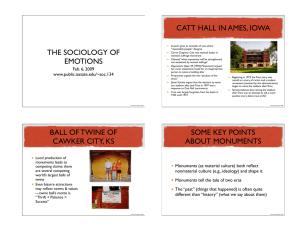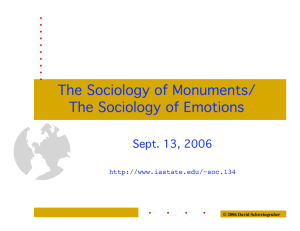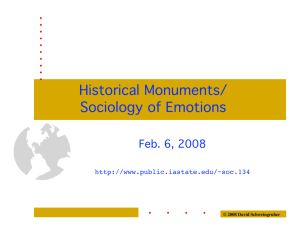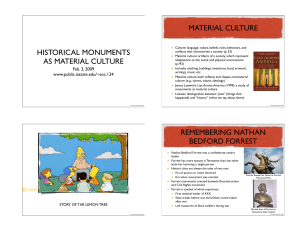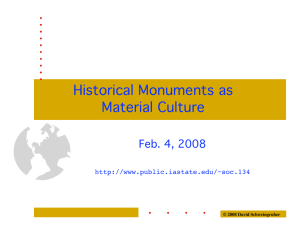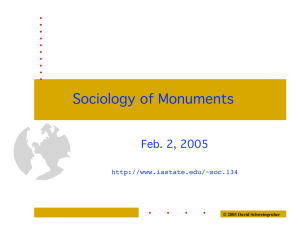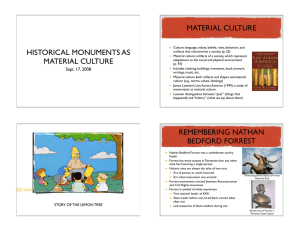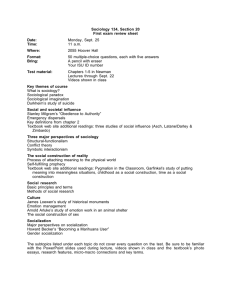INDIAN STATUE IN MUSCATINE, IOWA HISTORICAL MONUMENTS AS MATERIAL CULTURE/
advertisement
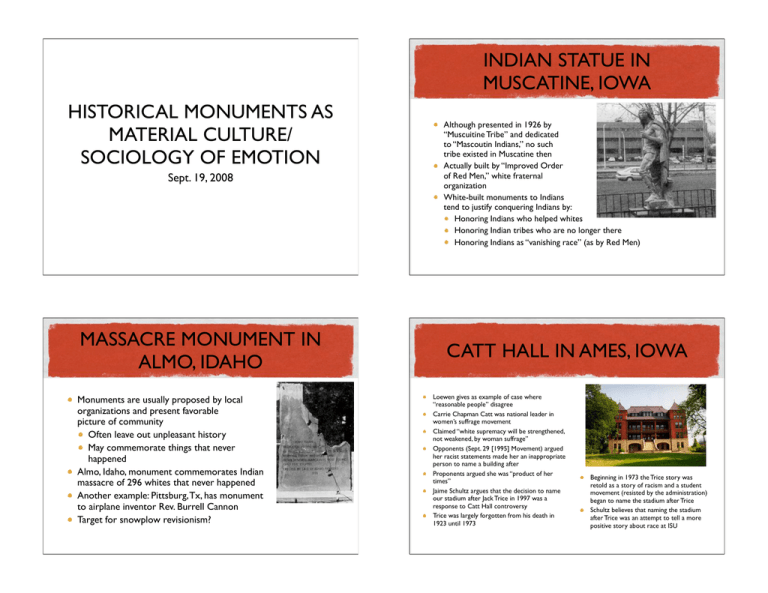
INDIAN STATUE IN MUSCATINE, IOWA HISTORICAL MONUMENTS AS MATERIAL CULTURE/ SOCIOLOGY OF EMOTION Sept. 19, 2008 MASSACRE MONUMENT IN ALMO, IDAHO Monuments are usually proposed by local organizations and present favorable picture of community Often leave out unpleasant history May commemorate things that never happened Almo, Idaho, monument commemorates Indian massacre of 296 whites that never happened Another example: Pittsburg, Tx, has monument to airplane inventor Rev. Burrell Cannon Target for snowplow revisionism? Although presented in 1926 by “Muscuitine Tribe” and dedicated to “Mascoutin Indians,” no such tribe existed in Muscatine then Actually built by “Improved Order of Red Men,” white fraternal organization White-built monuments to Indians tend to justify conquering Indians by: Honoring Indians who helped whites Honoring Indian tribes who are no longer there Honoring Indians as “vanishing race” (as by Red Men) CATT HALL IN AMES, IOWA Loewen gives as example of case where “reasonable people” disagree Carrie Chapman Catt was national leader in women’s suffrage movement Claimed “white supremacy will be strengthened, not weakened, by woman suffrage” Opponents (Sept. 29 [1995] Movement) argued her racist statements made her an inappropriate person to name a building after Proponents argued she was “product of her times” Jaime Schultz argues that the decision to name our stadium after Jack Trice in 1997 was a response to Catt Hall controversy Trice was largely forgotten from his death in 1923 until 1973 Beginning in 1973 the Trice story was retold as a story of racism and a student movement (resisted by the administration) began to name the stadium after Trice Schultz believes that naming the stadium after Trice was an attempt to tell a more positive story about race at ISU BALL OF TWINE OF CAWKER CITY, KS Local production of monuments leads to competing claims: there are several competing world’s largest balls of twine Even bizarre attractions may reflect norms & values —twine ball’s motto is “Thrift + Patience = Success” CULTURE AND EVERYDAY EXPERIENCE Nonmaterial culture: knowledge, beliefs, customs, values, morals, and symbols that are shaped by members of a society and that distinguish the society from others (p. 93) Nonmaterial culture shapes how we experience everyday life including: What diseases we experience (p. 108) The sick role (p. 108) How many sexes are there (p. 110) What emotions we experience (p. 103) SOME KEY POINTS ABOUT MONUMENTS Monuments (as material culture) both reflect nonmaterial culture (e.g., ideology) and shape it Monuments tell the tale of two eras The “past” (things that happened) is often quite different than “history” (what we say about them) THE SOCIOLOGY OF EMOTION Common-sense belief: Our emotions represent our “true” self, not social rules Sociology of emotions studies how culture shapes the way we feel Arlie Hochschild: pioneered sociology of emotions People do “emotion management”: attempting to make feelings correspond to feeling rules Emotion evocation: bringing about desired feeling Emotion suppression: stifling undesired feeling Organizations may demand emotion management from workers EMOTIONAL MANAGEMENT IN AN ANIMAL SHELTER HOMER IS GOING TO DIE Arnold Arluke (1994): participant observation in animal shelter How can society both treat animals with affection and kill them? Institution of animal shelter deals with this contradiction Employees must accept premise that sometimes it is necessary to kill animals Employees must be socialized to manage uncomfortable feelings about killing Arnold Arluke
